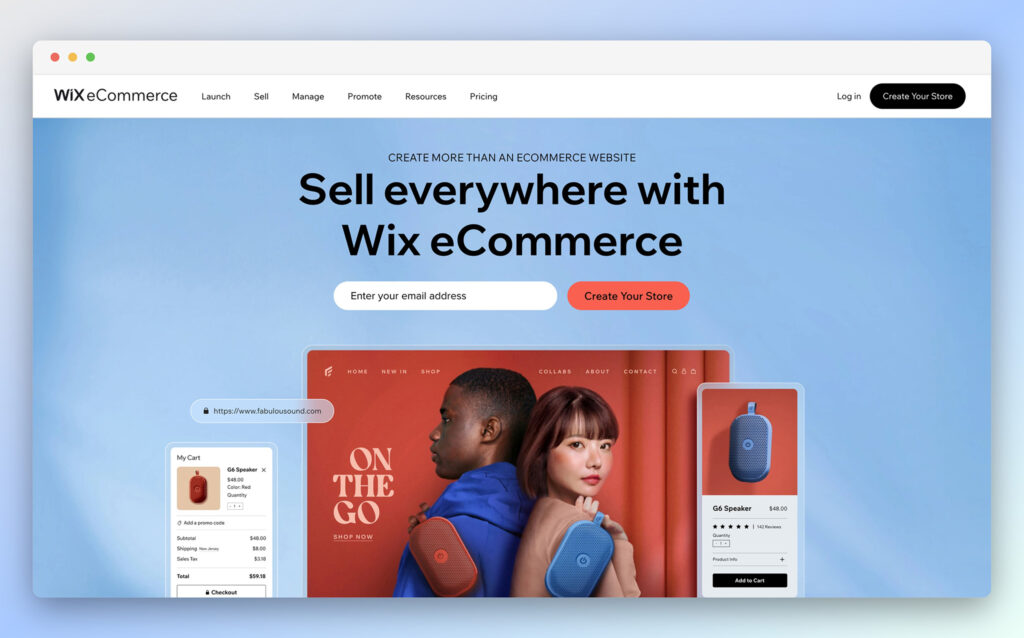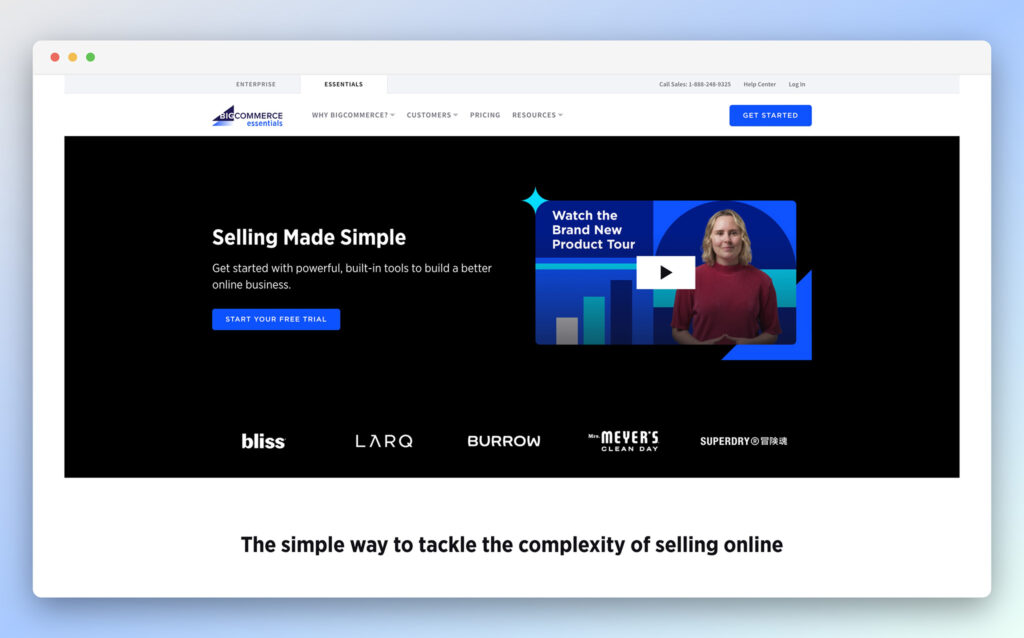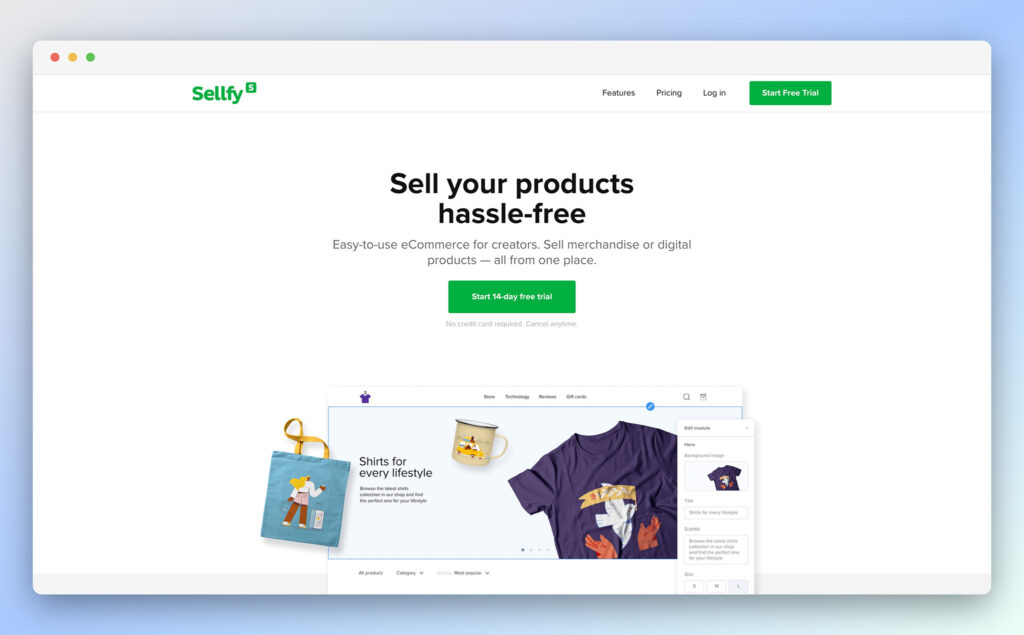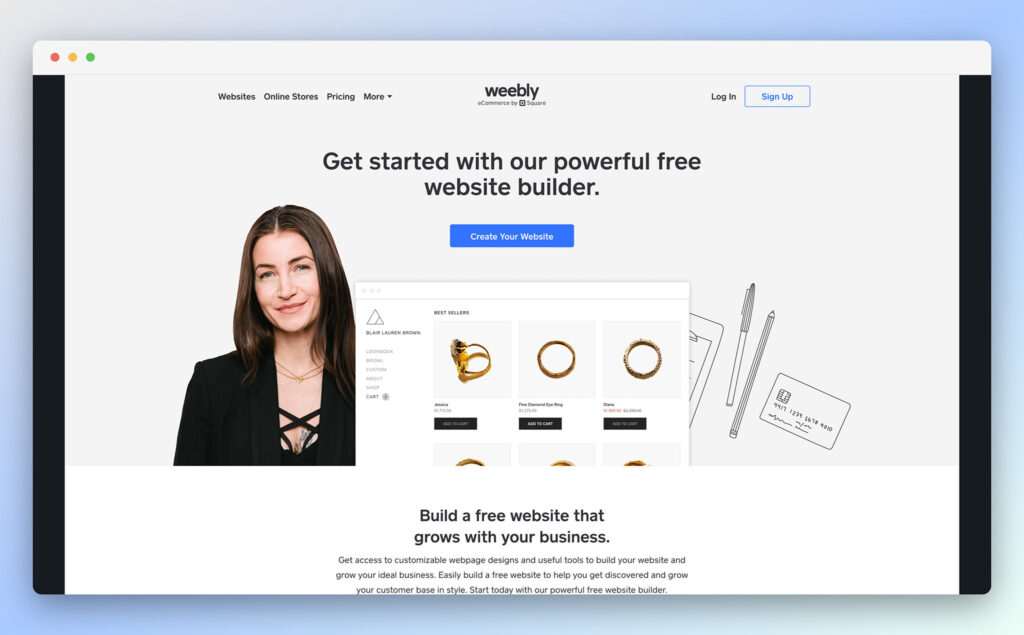After using and reviewing lots of online store builders in the past few years, I've selected the top 10 ecommerce platforms and shopping cart software that I think are the best fit for any needs. So before starting your online shop take a look at this comparison chart.
-
Our pick:
Features 10/10 Ease of Use 9/10 Pricing 9/10 Templates & Design 9/10 Inventory 9/10 SEO & Marketing 8/10 Payments 9/10 Security 9/10 Customer Support 10/10 -
Runner up:
Features 9/10 Ease of Use 10/10 Pricing 8/10 Templates & Design 9/10 Inventory 8/10 SEO & Marketing 9/10 Payments 9/10 Security 9/10 Customer Support 9/10 -
For large businesses:
Features 8/10 Ease of Use 7/10 Pricing 8/10 Templates & Design 8/10 Inventory 7/10 SEO & Marketing 8/10 Payments 8/10 Security 9/10 Customer Support 8/10 -
Budget pick:
Features 8/10 Ease of Use 7/10 Pricing 7/10 Templates & Design 7/10 Inventory 6/10 SEO & Marketing 6/10 Payments 9/10 Security 9/10 Customer Support 7/10 -
Best for small business:
Features 8/10 Ease of Use 7/10 Pricing 8/10 Templates & Design 9/10 Inventory 6/10 SEO & Marketing 5/10 Payments 8/10 Security 7/10 Customer Support 8/10 -
Features 8/10 Ease of Use 7/10 Pricing 7/10 Templates & Design 5/10 Inventory 6/10 SEO & Marketing 6/10 Payments 5/10 Security 6/10 Customer Support 8/10 -
Features 6/10 Ease of Use 4/10 Pricing 6/10 Templates & Design 7/10 Inventory 6/10 SEO & Marketing 7/10 Payments 7/10 Security 6/10 Customer Support 5/10 -
Features 7/10 Ease of Use 6/10 Pricing 5/10 Templates & Design 5/10 Inventory 4/10 SEO & Marketing 5/10 Payments 8/10 Security 6/10 Customer Support 6/10 -
Features 5/10 Ease of Use 7/10 Pricing 6/10 Templates & Design 4/10 Inventory 6/10 SEO & Marketing 5/10 Payments 4/10 Security 5/10 Customer Support 6/10 -
Features 6/10 Ease of Use 6/10 Pricing 6/10 Templates & Design 8/10 Inventory 4/10 SEO & Marketing 6/10 Payments 5/10 Security 5/10 Customer Support 4/10
Still not sure which ecommerce platform is best for you?
Anything else I need to know before launching my shop?
Most of these platforms or shopping carts are extremely easy to use, that's why I've chose them in the first place!
So your shop should be up and running in a couple of hours after you sign up for any of the ecommerce solutions above and for one of the recommended payment gateways.
However, as it's the case with brick and mortar shops, the challenging part is to get the word out about your store, get people inside and convince them to separate from their money in order to get what you're selling.
How do you rank the ecommerce website builders?
I thought you'd never ask! It's a pretty straightforward process really: I carefully review (and revisit every few months) each builder and grade its features on a scale from 1 to 10.
The chart above is automatically updated with the latest grades for each platform and ranks them accordingly.
There were quite a few changes in the last few months, but Shopify has been the #1 ecommerce platform from the very beginning of this blog, and it managed to stay there by constantly improving its structure and being at the forefront of the industry.If you're an established business with lots of products, clients and traffic, check out our Shopify Plus review.
Where can I find out more information about these shopping carts?
I did tons of detailed reviews, so please read my Shopify review, Shopify pricing guide, BigCommerce reviews, and Wix review.
Below, you can find more information about each platform listed in the chart:
Our Top Pick: Shopify

In any ecommerce platform comparison, Shopify will be one of the first names that crop up – and for a good reason! The online-store builder is a swiss army knife for ecommerce that makes selling online immensely beginner friendly.
You choose from one of eight free themes and customize your store to meet your brand's needs. Alternatively, you can purchase one of the hundreds of customizable premium themes available. These paid-for themes tend to boast more unique designs and extra functionality.
Once you're happy with your web design, you can add unlimited products without bandwidth limitations. Shopify also has intuitive dashboards from which you can oversee powerful analytics, inventory management, orders, fulfillment, etc.
If you're interested in executing a multi-channel sales strategy, you can connect with Amazon, Facebook, Pinterest, eBay, and more. There’s also the option to add a buy button to other websites, blogs, or social media shops.
Regarding payment gateways, Shopify offers tons, including notable names like PayPal, Klarna, and Braintree, to name a few! Shopify also has its own native payment processing system called Shopify Payments. Unfortunately, you’re subject to a 2% transaction fee if you use a third-party payment gateway.
Despite this drawback, Shopify is one of the most popular ecommerce platforms on the market. Moreover, thanks to its extensive app store, it's effortless to extend Shopify's functionality. But best of all, because of Shopify’s popularity, many app developers have designed plugins specifically for Shopify. So it’s always one of the first eCommerce platforms to access new and exciting integrations!
Shopify also comes with POS and allows you to add a blog to your site. There's no free trial, but the value for money you get on each of Shopify’s plans is without question. You’ll only have to upgrade once you start to scale your store and want additional features. For instance, more advanced reports, better shipping discounts, or more staff accounts. Rest assured, most of Shopify's significant sales features are included in the Basic Shopify plan.
Further reading:
- Read our full Shopify review here.
- Find out hat are the Best Ecommerce Platforms for Startups
Close Runner Up: Wix

In a thorough ecommerce platforms comparison, Wix should always emerge as one of the most intuitive website builders on the market. The platform offers over 800 themes and enables you to build a branded store with its simple drag-and-drop editor.
Every feature is easy-to-use and clearly labeled, making Wix an excellent option for beginners. In addition, each template is fully responsive, so your online store will look fabulous no matter which device customers use.
Regarding ecommerce, Wix is best suited to smaller online stores. It’s easy to get going with and is reasonably priced. You can manage products from one centralized dashboard and sell physical and digital items. In addition, Wix offers a simple SEO wizard that makes SEO optimizing your store a breeze, a media manager, blogging functionality and social sharing features.
You can offer customers a decent selection of payment methods, including PayPal, credit cards, and money transfers. However, unlike Shopify, Wix doesn’t charge extra transaction fees.
However, many of its selling features aren't as in-depth as Shopify's or BigCommerce's. For example, Wix doesn’t offer as much in the way of dropshipping, and omnichannel selling isn’t anywhere near as smooth with Wix as it is with Shopify.
Wix's plans also limit your storage space and the number of video hours you can upload. As such, large, established businesses might not find Wix scalable enough for their needs. Also, compared to ecommerce platforms like Shopify, Wix doesn’t offer many native dropshipping integrations.
Still, Wix brings a lot to the table, especially if you’re looking for a great user experience and intuitive customization. Plus, you can add newsletter functionality with paid add-on products like Wix Ascend. Not to mention, Wix has an app store with hundreds of widgets, making Wix pretty extendable. Lastly, you can access 24/7 support on all of Wix’s Business plans, which include live chat and email.
For Large Business: BigCommerce

BigCommerce’s prime purpose is in its name. The platform is designed for scalability. It empowers small and mid-sized businesses and international enterprises to succeed on the back of its features and services- which are even more extensive than Shopify’s.
BigCommerce is well-suited to both B2C and B2B businesses and comes with a range of wholesale capabilities. For example, you can create landing pages specifically for wholesale clients where they can log in and view wholesale prices. You can even customize these prices according to different customer groups and wholesale accounts.
BigCommerce doesn’t charge transaction fees on plans nor limits how much traffic you can drive to your site. However, the downside is that each pricing tier imposes a maximum annual revenue you can generate. So, you’re forced to upgrade as your ecommerce business expands and makes more money – even if you don't need the extra features that come with the more expensive plans.
However, BigCommerce comes with impressive SEO tools. It also provides everything you need to create complex navigational menus highlighting multiple product categories. In addition, you can create coupons and discounts, offer customers product recommendations, create faceted site searches, and enable payments through various digital wallets. For instance, BigCommerce accepts Apple Pay, Amazon Pay, PayPal One Touch, and more.
Where the platform falls somewhat short is in its content and blogging features. While BigCommerce offers a WordPress integration, it doesn’t provide a very advanced toolkit for blogging or creating landing pages on its platform. You also can’t develop multi-lingual stores.
You can find out more about BigCommerce in our review here.
Best for Small Business and Creatives: Squarespace

Squarespace is another all-in-one website and ecommerce solution. But, unlike many of its competitors, it tries to eradicate the need for third-party apps and plugins. Instead, it meticulously curates all the features you need to sell online.
Squarespace is often best known for its sleek and professional templates, making it the perfect choice for creatives. In addition, it comes with:
- A powerful in-browser image editor
- The ability to create stunning galleries
- Publish full-width images
- Tools to help you create social media posts and videos
Squarespace recently launched Fluid Engine, its new drag-and-drop editor that allows for layering objects and creating more flexible designs. While this interface is still new, there’s a good chance Squarespace will soon rival platforms like Webflow that offer a granular level of creative freedom.
Some of Squarespace’s most notable features include (available from the Business plan upwards):
- Email marketing.
- Managing appointments (paid add-on).
- Creating promotional popups and banners.
- Benefitting from a robust suite of SEO tools.
Squarespace’s ecommerce functionality is relatively robust. You can sell digital and physical products and subscriptions, and services. You can also accept donations and create membership sites.
You can also automate abandoned cart recovery campaigns and popups. In addition, Squarespace grants lots of control over your product pages. For instance, you can add forms, videos, product reviews, and related products to your product descriptions and even sync them with your Instagram feed. Plus, Squarespace Commerce plans come with unlimited products and bandwidth.
Squarespace’s ecommerce functionality is available at an affordable monthly price. However, its cheapest plan charges a 3% transaction fee on every sale you make.
Squarespace also has its own POS app, which allows you to accept and manage in-person payments via card, cash, and mobile payment. In addition, all POS transactions automatically sync with your online inventory and sales analytics. I.e., you can manage every aspect of your ecommerce business from your Squarespace account.
When managing inventory and shipping, you can:
- Automatically calculate tax rates
- Add limited availability labels to your product listings
- Offer flexible shipping options, such as free shipping, collection, and weight-based pricing
However, as Squarespace doesn’t offer many third-party plugins, it’s not as well suited to large businesses that might need to extend upon Squarespace’s functionality. For small businesses, however, Squarespace has absolutely everything you need and is, therefore, great value for money.
Best Budget Pick: Square Online

Square Online might be the right solution for you if you’re trying to run an online store on a tight budget. The platform allows you to build an ecommerce store for just the price of its payment processing (which depending on your pricing plan, ranges from 1.75% to 2.9%).
Square Online is pretty easy to use and has a solid range of features. For instance, you can count on free unlimited hosting, seamless integration with other Square products, basic inventory management features, responsive web design, and more. But, of course, to unlock more advanced features, you’ll have to upgrade to a premium plan.
Square Online also has plenty of nice-looking free themes to choose from. Or you can utilize paid themes from ThemeForest.
Best of all, thanks to Square’s POS, your physical sales, inventory, and orders sync with your online store. Plus, you can keep track of POS sales from the convenience of your Square Online dashboard.
Unfortunately, you often get what you pay for. So Square, unsurprisingly, has a few downsides compared to more prominent platforms like Shopify. For example:
- You can’t adjust shipping rates.
- Customer service has often been called into question.
- Some features are restricted to higher-cost pricing tiers. For instance, advanced reporting, product reviews, and cart recovery are only available on the Performance plan at $26 a month (billed annually) and upwards.
Square Online also doesn’t have a wide range of in-built marketing features. So you might find yourself without the tools you need to promote your store and improve its visibility in search rankings.
However, its affordability is a huge selling point- especially for traditional retail businesses already using Square products that want to expand online.
For more info, check out our Square Online review.
Sellfy

Sellfy is an ecommerce platform designed for creators that want to start offering branded merchandise to their readers or viewership using print-on-demand. In addition to accessing POD products, you can sell other physical and digital products and build a simple online store using Sellfy’s editor.
Sellfy’s POD service enables you to put your designs onto apparel, tote bags, phone cases, mugs, and canvases. However, your options are relatively limited compared to other POD platforms like Printify. In addition, its web design capabilities are also somewhat restrictive. Many of its templates are pretty simple and unimaginative. Beyond its colors, fonts, and logos, there’s not much you can customize about your Sellfy website.
On the plus side, you can sell via a buy button on your existing blogs and websites. Sellfy also offers an entirely free plan where you can list up to ten products on your online store. Once you upgrade to its Starter plan, you can list unlimited products, including digital and subscription products.
You also benefit from basic email marketing features. If you opt for a two-yearly plan, it's reasonably priced at just $19 a month, giving you a 13% discount compared to the yearly plan.
However, cart abandonment recovery and product upselling are only available on the Business plan, which is $59 a month when billed yearly (or $49 a month on the two-yearly plan).
If your focus is general ecommerce, Sellfy will no doubt be too limiting for you. But suppose all you’re after is a way to create some merchandise for your band, podcast, YouTube channel, blog, etc. In that case, the platform might provide a neat solution.
If you’re interested, we’ve reviewed Sellfy in more detail here.
WooCommerce

WooCommerce is WordPress’s ecommerce platform that you can add to the CMS as a free, open-source plugin. WooCommerce provides a range of online sales features, including payment processing, cart and checkout pages, inventory and order management features, and more.
If you’re already running a WordPress website, WooCommerce might be a no-brainer because it seamlessly integrates with your existing site. It also benefits from the same plugin directory and theme as WordPress does. As a result, you can access thousands of third-party apps, plugins, and themes. In addition, you can customize the look of your site with few limitations if you dig into the HTML and CSS. But, of course, you’ll need coding smarts for that!
In terms of in-built ecommerce features, with WooCommerce, you can:
- Automatically calculate taxes
- Upload products in bulk
- You decide which shipping carrier(s) you use.
- You can offer flexible payment options to customers, such as Google Pay, PayPal, and ApplePay, with support for over 135 currencies.
- Display product ratings and reviews
- Offer customers on-site search
- Organize products using filters
- Shoppers can check out as a guest or create a customer account on your website.
Like all good things, WooCommerce has some downsides. Although it’s a free platform, you’ll likely rely on a range of paid services like web hosting, security, plugins, and premium themes. These all add up!
WooCommerce, like WordPress, also comes with a considerably steeper learning curve than many of its competitors. After all, WooCommerce is a WordPress plugin, so you need a basic understanding of WordPress. Also, to add custom payment processor, coupons, buttons, etc., you'll have to use WooCommerce’s self-help documentation to teach yourself how to do this.
So, while WooCommerce is a very flexible and powerful open source ecommerce platform, it’s often best suited to those familiar with more advanced website building platforms. Likewise, it suits those with web development knowledge or larger businesses with dedicated web design teams.
Read our thoughts on WooCommerce here.
Ecwid

Unlike the other options on this list, Ecwid is a headless ecommerce solution. By this, we mean, Ecwid’s online selling features can be incorporated into any existing website. This comes in handy if you already have an established online brand and you just want to add ecommerce into the mix. It also allows users to sell on Facebook, Instagram, Amazon, and eBay.
With Ecwid, you don’t get default storefront templates. However, you can customize the product layout arrangement or item alignment. That said, customization options are pretty limited. However, you can tweak the CSS.
One neat feature is that you can manage your social media ads, create tax invoices, create gift cards and discount coupons, and more from your dashboard! Ecwid also has an app store full of plugins you can download and use to extend Ecwid’s functionality.
However, whether Ecwid is right for your business depends greatly on your needs and existing infrastructure. For instance, it’s not very good at building full-fledged online stores from scratch. If that’s what you’re after, a website builder like Squarespace or Wix might be a better option if you don’t already have a website you love. Ecwid’s SEO capabilities are also subpar, as you can’t edit product URLs.
Ecwid has a free plan that allows you to sell up to ten products. However, unlimited products are sadly only available on its most expensive plan, which costs $99 a month (when billed monthly).
At $35 a month (based on monthly billing), its Business plan comes in at a similar monthly price to Shopify and offers a good range of features. However, you’re limited to listing 2,500 products in your store.
But, it’s worth noting that all plans have unlimited bandwidth and support up to 25GB of digital products!
Learn more about Ecwid in our dedicated review.
Weebly

Owned and powered by Square, Weebly is a simple drag-and-drop website builder with ecommerce capabilities. That’s right – while not to be confused with Square Online, Weebly has the same parent company, and its payment processing and POS focus entirely on Square’s services.
Weebly’s most significant selling point is that it’s effortless to use, which makes it attractive to small companies that aren’t tech-savvy. Its interface is straightforward and comes with intuitive product management. Like Wix, you can access Weebly’s features from a simple dashboard and build your website starting from a theme. Once you’ve picked a theme you like, simply drag and drop elements onto the page. You can then edit these elements (should you wish). For instance, you can customize colors, fonts, and backgrounds effortlessly.
However, Weebly’s themes aren’t the sleekest on the market. One issue is that they aren’t always the most mobile responsive, which is a significant drawback when you consider that lots of ecommerce transactions happen on the go.
Regarding ecommerce, Weebly allows you to sell physical and digital products (up to 3GB) and comes with an app center that enables you to add more functionality to your Weebly site. For example, customer reviews and a blog.
Weebly calculates sales and shipping tax and accepts a wide range of international currencies. You can accept all major credit cards and process payments via Stripe and PayPal.
You can add unlimited items on all paid plans, present multiple item variants, create coupons and shipping labels, and offer Square gift cards.
Weebly also lets you design popup notifications for marketing purposes and enables you to publish lead capture forms.
Pricing plans start incredibly cheap, at $16 monthly for the Professional program (based on monthly billing). However, this comes with the payoff that, compared to many of its competitors, Weebly isn’t as advanced.
But, suppose your business only has basic ecommerce needs and isn’t picky about its website appearance. In that case, a Weebly site might be enough for you. However, anyone wanting to scale their business will sooner or later need to move away from Weebly to a more robust ecommerce software.
Want more info on Weebly? Here’s our full review.
Webflow

Although Webflow has been around for a while, it had its major breakthrough in 2017 when it marketed itself as a way to design professional websites without the need to code. All the while maintaining the customizability and design freedom of hand-coded web design.
Webflow didn’t over-promise! Its impressively flexible editor uses a grid that enables you to drag and drop elements nearly anywhere you like. It supports a layering system that allows you to combine elements creatively and overlay text over images. In addition, you can:
- Adjust the opacity of elements
- Finetune typography down to line height and kerning
- Utilize blending modes that designers will be familiar with from software like Adobe Photoshop
…to name a few!
The editor converts all changes into clean code, which can then be picked up by your development team. In other words, Webflow is a great solution for design teams that want to collaborate across disciplines.
However, while these features might be intuitive to old-fashioned designers, they can be overwhelming for those who come from other, more straightforward website builders. So a learning curve is to be expected.
Ecommerce came later. However, Webflow now comes with a fully customizable checkout and shopping cart. You can also sell paid memberships, send customized emails, register multiple staff accounts, create shopping rules, and more.
In addition, Webflow facilitates PayPal, Stripe, Apple Pay, and credit card payments with automatic tax calculation. Depending on your payment plan, you can sell between 500 and 3,000 physical or digital items in your store. However, the cheapest ecommerce plan comes with a 2% transaction fee on every sale you make/
Webflow supports your selling efforts with a flexible, albeit somewhat complex, CMS, powerful SEO features, engaging animations, the ability to create product variants, and more. Overall, however, its inventory management is basic, and there’s no customer support via phone.
Webflow has many features that make it unique and interesting to designers, agencies, and businesses alike. However, Webflow’s focus isn’t ecommerce as much as it is its web design editor and CMS, which means it isn’t as feature-rich as some of our other competing ecommerce platforms.
That said, Webflow has a free plan for unpublished websites, so you can check whether Webflow feels suitable for you without any financial commitment. Get more details in our full Webflow review here.
Can you help me to create a shop using Shopify / Magento / WooCommerce / etc?
Yes I do work with experts in each of these shopping carts. Please fill out this form to make sure I will be able recommend you the right people to work with.










